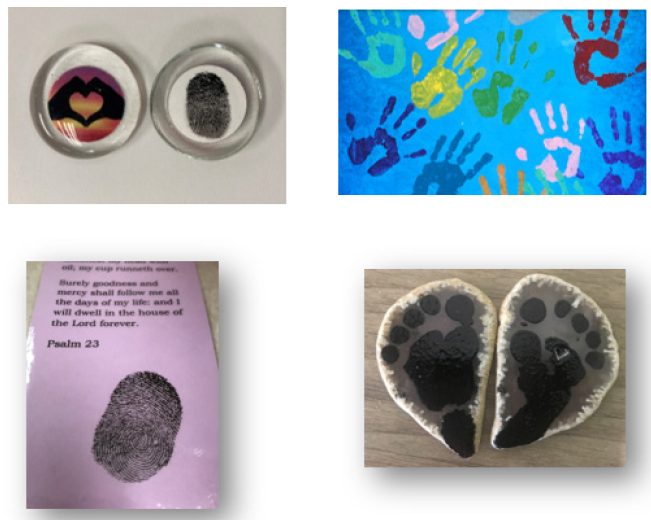- Submissions

Full Text
COJ Nursing & Healthcare
Legacy Work: Transforming Grief for Families and Staff
Laura Baker* and Jessica Bullington
Palliative Care and Complementary Therapies, USA
*Corresponding author: Laura Baker, Palliative Care and Complementary Therapies, USA
Submission: February 17, 2022Published: March 04, 2022

ISSN: 2577-2007Volume7 Issue5
Introduction
Legacies are anything left behind that help our loved ones hold us in their hearts and minds. For the bereaved, Legacy Work (LW) can help with closure and healing especially in the hospital setting. LW at end-of-life is utilized in our hospitals to promote coping and connection for grieving families. This process is facilitated by offering “Memory Stones” with comforting or commemorative images upon which the patient’s fingerprint can also be placed. LW creates a tangible object for families experiencing one of life’s most painful transitions, death. Over the years we have expanded our LW program to include hand, finger, and footprints on various materials such as canvases, bookmarks, rocks, and fabrics. Staff members have printed heart rhythm strips, cut locks of hair, and assisted with journaling and letter writing. The stories shared by these beside providers and families are powerful and inspiring and show how even a small Legacy program can make a big impact.
In 2015, LW was initiated in ICU units and championed by a handful of trained nurses. One nurse shared how LW helped transform the bedside during a challenging case. An 11-year-old boy wanted to spend time at his dad’s bedside in the days before his death. “The boy was so afraid but determined to go in and see him. But after we made fingerprints and handprints with his dad’s favorite music playing, he was relaxed, smiling and showing his cousin how to do the prints himself. Tense and angry family members softened. It was amazing”. Seeing that transformation alleviated some of the grief this nurse felt for this family. A common theme, staff often report feelings of “shared grief” and “closure” with the families who receive LW. While the LW program was initiated and is sustained through the Palliative Care department, bedside staff have fully embraced it and facilitate LW autonomously whenever needed.
During the Covid-19 pandemic, LW became a vital source of comfort. Bedside staff found themselves holding a continuous vigil amidst their own exhaustion and fear. As patients died in isolation, physically separated from family and friends, healthcare providers remained at the bedside doing their best to help families say goodbye from a safe distance. Bedside staff have shared how LW impacted them during this time. Many themes emerged from these stories including family and provider connection to each other and patients. An ICU RN shared, “[visitor] restrictions have really parsed down how much I learn about a patient…but memory stones typically help me learn so much more about them as a person and not a patient”. One ICU PA felt that LW is a “small way for families to feel included in the dying process”.
Providers who have shared their experiences, consistently make statements demonstrating how LW returns humanity to themselves and the bedside. “Legacy Work is an integral part of alleviating bedside compassion fatigue because it allows us to create positive moments in difficult times that are easier to focus on as we continue our service.”
LW has provided the opportunity for positive experiences in otherwise bleak situations for families and healthcare providers. The shadow cast by the Covid-19 pandemic has intensified feelings of moral distress and compassion fatigue within our institution. LW has been one beacon of light for those experiencing end of life more and more. As one ICU staff member shared, “[LW is] the most useful tool we have for families during a patient’s passing, and this has never been truer than during COVID”.
Figure 1:

© 2022 Laura Baker. This is an open access article distributed under the terms of the Creative Commons Attribution License , which permits unrestricted use, distribution, and build upon your work non-commercially.
 a Creative Commons Attribution 4.0 International License. Based on a work at www.crimsonpublishers.com.
Best viewed in
a Creative Commons Attribution 4.0 International License. Based on a work at www.crimsonpublishers.com.
Best viewed in 







.jpg)






























 Editorial Board Registrations
Editorial Board Registrations Submit your Article
Submit your Article Refer a Friend
Refer a Friend Advertise With Us
Advertise With Us
.jpg)






.jpg)














.bmp)
.jpg)
.png)
.jpg)










.jpg)






.png)

.png)



.png)






